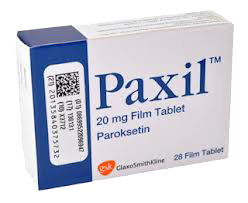What is Paxil?
Paxil (paroxetine) is an antidepressant in a group of drugs called selective serotonin reuptake inhibitors (SSRIs). Paroxetine affects chemicals in the brain that may be unbalanced in people with depression, anxiety, or other disorders.
Paxil is used to treat depression, obsessive-compulsive disorder, anxiety disorders, post-traumatic stress disorder (PTSD), and premenstrual dysphoric disorder (PMDD).
Paxil may also be used for purposes not listed in this medication guide.
Important information
You should not use Paxil if you are also taking pimozide or thioridazine, or if you are being treated with methylene blue injection. Do not start or stop taking this medicine during pregnancy without your doctor’s advice.
Do not use Paxil if you have used an MAO inhibitor in the past 14 days, such as isocarboxazid, linezolid, methylene blue injection, phenelzine, rasagiline, selegiline, or tranylcypromine.
Some young people have thoughts about suicide when first taking an antidepressant. Stay alert to changes in your mood or symptoms. Report any new or worsening symptoms to your doctor.
Do not give Paxil to anyone younger than 18 years old without the advice of a doctor. Paroxetine is not approved for use in children.
Before taking this medicine
You should not use Paxil if you are allergic to paroxetine, or if:
you are also taking pimozide or thioridazine; or
you are being treated with methylene blue injection.
Do not use an MAO inhibitor within 14 days before or after you take Paxil. A dangerous drug interaction could occur. MAO inhibitors include isocarboxazid, linezolid, phenelzine, rasagiline, selegiline, and tranylcypromine. After you stop taking Paxil you must wait at least 14 days before you start taking an MAO inhibitor.
To make sure Paxil is safe for you, tell your doctor if you have:
heart disease, high blood pressure, history of stroke;
liver or kidney disease;
a bleeding or blood clotting disorder;
seizures or epilepsy;
bipolar disorder (manic depression), or a history of drug abuse or suicidal thoughts;
narrow-angle glaucoma; or
low levels of sodium in your blood.
Some young people have thoughts about suicide when first taking an antidepressant. Your doctor should check your progress at regular visits. Your family or other caregivers should also be alert to changes in your mood or symptoms.
Taking an SSRI antidepressant during pregnancy may cause serious lung problems or other complications in the baby. However, you may have a relapse of depression or other treated condition if you stop taking your antidepressant. Tell your doctor right away if you become pregnant. Do not start or stop taking this medicine during pregnancy without your doctor’s advice.
Paroxetine can pass into breast milk and may harm a nursing baby. You should not breast-feed while using this medicine.
Do not give Paxil to anyone younger than 18 years old without the advice of a doctor. Paroxetine is not approved for treating depression in children.
How should I take Paxil?
Take Paxil exactly as prescribed by your doctor. Follow all directions on your prescription label. Your doctor may occasionally change your dose to make sure you get the best results. Do not take this medicine in larger or smaller amounts or for longer than recommended.
Do not crush, chew, or break an extended-release tablet. Swallow it whole.
Shake the oral suspension (liquid) well just before you measure a dose. Measure liquid medicine with the dosing syringe provided, or with a special dose-measuring spoon or medicine cup. If you do not have a dose-measuring device, ask your pharmacist for one.
It may take up to 4 weeks before your symptoms improve. Keep using the medication as directed and tell your doctor if your symptoms do not improve.
Do not stop using Paxil suddenly, or you could have unpleasant withdrawal symptoms. Ask your doctor how to safely stop using Paxil. Follow your doctor’s instructions about tapering your dose.
Store at room temperature away from moisture, heat, and light.
What happens if I miss a dose?
Take the missed dose as soon as you remember. Skip the missed dose if it is almost time for your next scheduled dose. Do not take extra medicine to make up the missed dose.
What happens if I overdose?
Seek emergency medical attention. An overdose of paroxetine can be fatal.
What should I avoid while taking Paxil?
Drinking alcohol can increase some of the side effects of Paxil.
Ask your doctor before taking a nonsteroidal anti-inflammatory drug (NSAID) for pain, arthritis, fever, or swelling. This includes aspirin, ibuprofen (Advil, Motrin), naproxen (Aleve), celecoxib (Celebrex), diclofenac, indomethacin, meloxicam, and others. Using an NSAID with Paxil may cause you to bruise or bleed easily.
This medication may impair your thinking or reactions. Be careful if you drive or do anything that requires you to be alert.
Paxil side effects
Get emergency medical help if you have any signs of an allergic reaction to Paxil: skin rash or hives; difficulty breathing; swelling of your face, lips, tongue, or throat.
Report any new or worsening symptoms to your doctor, such as: mood or behavior changes, anxiety, panic attacks, trouble sleeping, or if you feel impulsive, irritable, agitated, hostile, aggressive, restless, hyperactive (mentally or physically), more depressed, or have thoughts about suicide or hurting yourself.
Call your doctor at once if you have:
racing thoughts, decreased need for sleep, unusual risk-taking behavior, feelings of extreme happiness or sadness, being more talkative than usual;
blurred vision, tunnel vision, eye pain or swelling, or seeing halos around lights;
unusual bone pain or tenderness, swelling or bruising;
changes in weight or appetite;
easy bruising, unusual bleeding (nose, mouth, vagina, or rectum), coughing up blood;
high levels of serotonin in the body–agitation, hallucinations, fever, fast heart rate, overactive reflexes, nausea, vomiting, diarrhea, loss of coordination, fainting;
low levels of sodium in the body–headache, confusion, slurred speech, severe weakness, loss of coordination, feeling unsteady;
severe nervous system reaction–very stiff (rigid) muscles, high fever, sweating, confusion, fast or uneven heartbeats, tremors, fainting; or
severe skin reaction–fever, sore throat, swelling in your face or tongue, burning in your eyes, skin pain, followed by a red or purple skin rash that spreads (especially in the face or upper body) and causes blistering and peeling.
Common Paxil side effects may include:
vision changes;
weakness, drowsiness, dizziness;
sweating, anxiety, shaking;
sleep problems (insomnia);
loss of appetite, constipation;
dry mouth, yawning; or
decreased sex drive, impotence, or difficulty having an orgasm.
This is not a complete list of side effects and others may occur. Call your doctor for medical advice about side effects.
What other drugs will affect Paxil?
Taking this medicine with other drugs that make you sleepy can worsen this effect. Ask your doctor before taking Paxil with a sleeping pill, narcotic pain medicine, muscle relaxer, or medicine for anxiety, depression, or seizures.
Tell your doctor about all medicines you use, and those you start or stop using during your treatment with Paxil, especially:
atomoxetine, cimetidine (Tagamet), metoprolol, procyclidine, St. John’s wort, tamoxifen;
tryptophan (sometimes called L-tryptophan);
a blood thinner (warfarin, Coumadin, Jantoven);
heart rhythm medicine;
HIV or AIDS medications;
narcotic pain medicine–fentanyl, tramadol;
medicine to treat mood disorders, thought disorders, or mental illness–such as lithium, other antidepressants, or antipsychotics;
migraine headache medicine–sumatriptan, rizatriptan, zolmitriptan, and others; or
seizure medicine–carbamazepine, phenytoin.
This list is not complete. Other drugs may interact with paroxetine, including prescription and over-the-counter medicines, vitamins, and herbal products. Not all possible interactions are listed in this medication guide.


